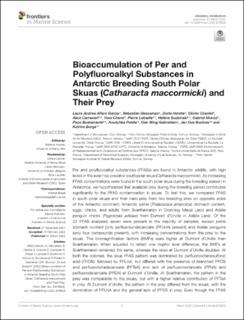| dc.contributor.author | Alfaro Garcia, Laura Andrea | |
| dc.contributor.author | Descamps, Sebastien | |
| dc.contributor.author | Herzke, Dorte | |
| dc.contributor.author | Chastel, Olivier | |
| dc.contributor.author | Carravieri, Alice | |
| dc.contributor.author | Cherel, Yves | |
| dc.contributor.author | Labadie, Pierre | |
| dc.contributor.author | Budzinski, Helene | |
| dc.contributor.author | Munoz, Gabriel | |
| dc.contributor.author | Bustamante, Paco | |
| dc.contributor.author | Polder, Anuschka | |
| dc.contributor.author | Gabrielsen, Geir Wing | |
| dc.contributor.author | Bustnes, Jan Ove | |
| dc.contributor.author | Borgå, Katrine | |
| dc.date.accessioned | 2023-03-27T09:20:50Z | |
| dc.date.available | 2023-03-27T09:20:50Z | |
| dc.date.created | 2022-04-26T15:36:19Z | |
| dc.date.issued | 2022 | |
| dc.identifier.citation | Frontiers in Marine Science. 2022, 9 . | en_US |
| dc.identifier.issn | 2296-7745 | |
| dc.identifier.uri | https://hdl.handle.net/11250/3060526 | |
| dc.description.abstract | Per and polyfluoroalkyl substances (PFASs) are found in Antarctic wildlife, with high levels in the avian top predator south polar skua (Catharacta maccormicki). As increasing PFAS concentrations were found in the south polar skua during the breeding season in Antarctica, we hypothesised that available prey during the breeding period contributes significantly to the PFAS contamination in skuas. To test this, we compared PFAS in south polar skuas and their main prey from two breeding sites on opposite sides of the Antarctic continent: Antarctic petrel (Thalassoica antarctica) stomach content, eggs, chicks, and adults from Svarthamaren in Dronning Maud Land and Adélie penguin chicks (Pygoscelis adeliae) from Dumont d’Urville in Adélie Land. Of the 22 PFAS analysed, seven were present in the majority of samples, except petrel stomach content [only perfluoroundecanoate (PFUnA) present] and Adélie penguins (only four compounds present), with increasing concentrations from the prey to the skuas. The biomagnification factors (BMFs) were higher at Dumont d’Urville than Svarthamaren. When adjusted to reflect one trophic level difference, the BMFs at Svarthamaren remained the same, whereas the ones at Dumont d’Urville doubled. At both the colonies, the skua PFAS pattern was dominated by perfluorooctanesulfonic acid (PFOS), followed by PFUnA, but differed with the presence of branched PFOS and perfluorotetradecanoate (PFTeA) and lack of perfluorononanoate (PFNA) and perfluorodecanoate (PFDA) at Dumont d’Urville. At Svarthamaren, the pattern in the prey was comparable to the skuas, but with a higher relative contribution of PFTeA in prey. At Dumont d’Urville, the pattern in the prey differed from the skuas, with the domination of PFUnA and the general lack of PFOS in prey. Even though the PFAS levels are low in Antarctic year-round resident prey, the three lines of evidence (pattern, BMF difference, and BMF adjusted to one trophic level) suggest that the Antarctic petrel are the significant source of PFAS in the Svarthamaren skuas, whereas the skuas in Dumont d’Urville have other important sources to PFAS than Adélie penguin, either in the continent or external on the inter-breeding foraging grounds far from Antarctica. | |
| dc.description.abstract | Bioaccumulation of Per and Polyfluoroalkyl Substances in Antarctic Breeding South Polar Skuas (Catharacta maccormicki) and Their Prey | |
| dc.language.iso | eng | en_US |
| dc.subject | Miljøgifter | |
| dc.subject | Environmental pollution | |
| dc.subject | Antarktis | |
| dc.subject | Antarctica | |
| dc.subject | Sjøfugl | |
| dc.subject | Seabirds | |
| dc.title | Bioaccumulation of Per and Polyfluoroalkyl Substances in Antarctic Breeding South Polar Skuas (Catharacta maccormicki) and Their Prey | en_US |
| dc.title.alternative | Bioaccumulation of Per and Polyfluoroalkyl Substances in Antarctic Breeding South Polar Skuas (Catharacta maccormicki) and Their Prey | en_US |
| dc.type | Peer reviewed | en_US |
| dc.type | Journal article | en_US |
| dc.description.version | publishedVersion | |
| dc.description.version | publishedVersion | |
| dc.subject.nsi | VDP::Økotoksikologi: 489 | |
| dc.subject.nsi | VDP::Eco-toxicology: 489 | |
| dc.source.pagenumber | 14 | en_US |
| dc.source.volume | 9 | en_US |
| dc.source.journal | Frontiers in Marine Science | en_US |
| dc.identifier.doi | 10.3389/fmars.2022.819525 | |
| dc.identifier.cristin | 2019262 | |
| dc.relation.project | Norges forskningsråd: 243763 | |
| dc.relation.project | NILU - Norsk institutt for luftforskning: 114029 | |
| dc.relation.project | Norges forskningsråd: 247698 | |
| dc.relation.project | Klima- og miljødepartementet: QZA-15/0137 | |
| cristin.ispublished | true | |
| cristin.fulltext | original | |
| cristin.fulltext | original | |
| cristin.qualitycode | 1 | |
